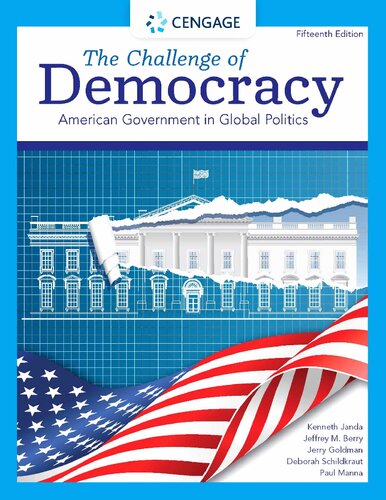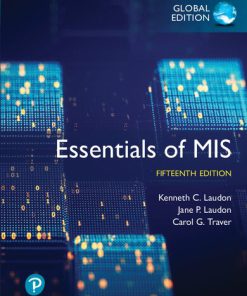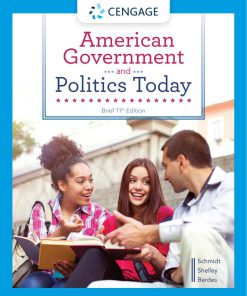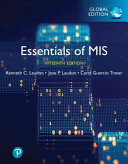The Challenge of Democracy American Government in Global Politics 15th Edition by Kenneth Janda 0357459377 978-0357459379
$50.00 Original price was: $50.00.$25.00Current price is: $25.00.
The Challenge of Democracy American Government in Global Politics 15th Edition by Kenneth Janda – Ebook PDF Instant Download/Delivery: 0357459377, 978-0357459379
Full download The Challenge of Democracy American Government in Global Politics 15th Edition after payment

Product details:
ISBN 10: 0357459377
ISBN 13: 978-0357459379
Author: Kenneth Janda
AMERICAN GOVERNMENT IN GLOBAL POLITICS, 15th edition, explores how the clash of values surrounding freedom, order and equality characterize U.S. politics. It illustrates tensions between majoritarian and pluralist views of democracy across the political landscape and examines how U.S. political institutions and outputs compare to those in other countries. It also highlights the fragility of American democracy. New coverage includes the impact of the COVID-19 pandemic on the economy, the rise of fake news, the impeachment of President Trump, the impact of social media on political activity and democratic discourse, gun control, immigration politics, education policy, and more. Also available, the MindTap digital learning solution includes an interactive ebook, self-assessment tools and more.
The Challenge of Democracy American Government in Global Politics 15th Table of contents:
Part I. Dilemmas of Democracy
Chapter 1. Freedom, Order, or Equality?
The Globalization of American Government
The Purposes of Government
Maintaining Order
Providing Public Goods
Promoting Equality
A Conceptual Framework for Analyzing Government
The Concepts of Freedom, Order, and Equality
Freedom
Order
Equality
Two Dilemmas of Government
The Original Dilemma: Freedom versus Order
The Modern Dilemma: Freedom versus Equality
Ideology and the Scope of Government
Totalitarianism
Socialism
Capitalism
Libertarianism
Anarchism
Liberals and Conservatives: The Narrow Middle
American Political Ideologies and the Purpose of Government
Liberals versus Conservatives: The New Differences
A Two-Dimensional Classification of Ideologies
Summary
Chapter Quiz
Chapter 2. Majoritarian or Pluralist Democracy?
The Theory of Democratic Government
The Meaning and Symbolism of Democracy
The Procedural View of Democracy
A Complication: Direct versus Indirect Democracy
The Substantive View of Democracy
Procedural Democracy versus Substantive Democracy
Institutional Models of Democracy
The Majoritarian Model of Democracy
An Alternative Model: Pluralist Democracy
The Majoritarian Model versus the Pluralist Model
An Undemocratic Model: Elite Theory
Elite Theory versus Pluralist Theory
The Global Challenge of Democratization
Establishing Democracies
American Democracy: Pluralist and Majoritarian
Summary
Chapter Quiz
Part II. Foundations of American Government
Chapter 3. The Constitution
The Revolutionary Roots of the Constitution
Freedom in Colonial America
The Road to Revolution
Revolutionary Action
The Declaration of Independence
From Revolution to Confederation
The Articles of Confederation
Disorder Under the Confederation
From Confederation to Constitution
The Virginia Plan
The New Jersey Plan
The Great Compromise
Compromise on the Presidency
The Final Product
The Basic Principles
The Articles of the Constitution
The Framers’ Motives
The Slavery Issue
Selling the Constitution
The Federalist Papers
A Concession: The Bill of Rights
Ratification
Constitutional Change
The Formal Amendment Process
Interpretation by the Courts
Political Practice
An Evaluation of the Constitution
Freedom, Order, and Equality in the Constitution
The Constitution and Models of Democracy
Summary
Chapter Quiz
Chapter 4. Federalism
Theories and Metaphors
Dual Federalism
Cooperative Federalism
Dual, Cooperative, or Something Else?
Federalism’s Dynamics
National Crises and Demands
Judicial Interpretation
Grants-in-Aid
Professionalization of State Governments
Ideology, Policymaking, and American Federalism
Ideology, Policymaking, and Federalism in Theory
National Intervention in State Functions
Ideology, Policymaking, and Federalism in Practice
Federalism and Electoral Politics
National Capital–State Capital Links
Congressional Redistricting
Federalism and the American Intergovernmental System
Thousands of Governments
Crosscutting Responsibilities
Federalism and the International System
American Federalism, Immigration, and Refugee Policy
Federalism Across the Globe
Federalism, Pluralism, and Majoritarianism
Summary
Chapter Quiz
Part III. Linking People with Government
Chapter 5. Public Opinion and Political Socialization
Public Opinion and the Models of Democracy
The Distribution of Public Opinion
Measuring the Distribution of Public Opinion
Shape of the Distribution
Political Socialization
The Agents of Early Socialization
Social Groups and Political Values
Education
Income
Region
Ethnicity and Race
Religion
Gender
From Values to Ideology
The Degree of Ideological Thinking in Public Opinion
The Quality of Ideological Thinking in Public Opinion
Ideological Types in the United States
Forming Political Opinions
Political Knowledge
Costs, Benefits, and Cues
Political Leadership
Summary
Chapter Quiz
Chapter 6. The Media
The Development of the Mass Media in the United States
Newspapers
Radio
Television
The Internet
Private Ownership of the Media
The Consequences of Private Ownership
The Concentration of Private Ownership
Government Regulation of the Media
Technical and Ownership Regulations
Regulation of Content
Functions of the Mass Media for the Political System
Reporting the News
Interpreting and Presenting the News
Setting the Political Agenda
Socializing the Citizenry
Evaluating the Media in Government
Is Reporting Biased?
Contributions to Democracy
Effects on Freedom, Order, and Equality
Summary
Chapter Quiz
Chapter 7. Participation and Voting
Democracy and Political Participation
Unconventional Participation
Support for Unconventional Participation
The Effectiveness of Unconventional Participation
Unconventional Participation Around the World
Conventional Participation
Supportive Behavior
Influencing Behavior
Conventional Participation in America
Participating Through Voting
Expansion of Suffrage
Voting on Policies
Voting for Candidates
Explaining Political Participation
Patterns of Participation over Time
The Standard Socioeconomic Explanation
Low Voter Turnout in America
Participation and Freedom, Equality, and Order
Participation and Freedom
Participation and Equality
Participation and Order
Participation and the Models of Democracy
Participation and Majoritarianism
Participation and Pluralism
Summary
Chapter Quiz
Chapter 8. Political Parties
Political Parties and Their Functions
What Is a Political Party?
Party Functions
A History of US Party Politics
The Preparty Period
The First Party System: Federalists and Democratic Republicans
The Second Party System: Democrats and Whigs
The Current Party System: Democrats and Republicans
Eras of Party Dominance Since the Civil War
The American Two-Party System
Minor Parties in America
Why a Two-Party System?
The Federal Basis of the Party System
Party Identification in America
Party Ideology and Organization
Differences in Party Ideology
National Party Organization
State and Local Party Organizations
Congressional versus External Party Organizations
The Model of Responsible Party Government
Summary
Chapter Quiz
Chapter 9. Nominations, Elections, and Campaigns
The Evolution of Campaigning
Nominations
Nomination for Congress and State Offices
Nomination for President
Elections
Presidential Elections and the Electoral College
Congressional Elections
Campaigns
The Political Context
Financing
Strategies and Tactics
Explaining Voting Choice
Party Identification
Issues and Policies
Candidates’ Attributes
Evaluating the Voting Choice
Campaign Effects
Campaigns, Elections, and Parties
Parties and the Majoritarian Model
Parties and the Pluralist Model
Summary
Chapter Quiz
Chapter 10. Interest Groups
Interest Groups and the American Political Tradition
Interest Groups and American Democracy
The Roles of Interest Groups
What Interests Are Represented?
How Interests Get Organized
How Do Interest Groups Exert Influence?
Members
Lobbyists
Political Action Committees
Lobbying Tactics
Direct Lobbying
Information Campaigns
Coalition Building
Are Interest Groups Effective?
Legislative
Lobbying Beyond the Legislative Branch
Is the System Biased?
Membership Patterns
Business Mobilization
Citizen Groups
Reform
Summary
Chapter Quiz
Part IV. Institutions of Government
Chapter 11. Congress
The Origin and Powers of Congress
The Great Compromise
Duties of the House and Senate
Electing Congress
The Incumbency Effect
Whom Do We Elect?
How Issues Get on the Congressional Agenda
The Lawmaking Process and the Importance of Committees
Committees: The Workhorses of Congress
Congressional Expertise and Seniority
Oversight: Following Through on Legislation
Majoritarian and Pluralist Views of Committees
Leaders and Followers in Congress
The Leadership Task
Rules of Procedure
How a Bill Becomes a Law in an Era of Partisan Polarization
The Legislative Environment
Political Parties
The President
Constituents
Interest Groups
The Dilemma of Representation
Trustees or Delegates?
Pluralism, Majoritarianism, and Democracy
Parliamentary Government
Pluralism vs. Majoritarianism in Congress
Summary
Chapter Quiz
Chapter 12. The Presidency
The Constitutional Basis of Presidential Power
Initial Conceptions of the Presidency
The Powers of the President
The Expansion of Presidential Power
The Growth of Formal Powers
The Inherent Powers
Unilateral Action
Congressional Delegation of Power
The Executive Branch Establishment
The Executive Office of the President
The Vice President
The Cabinet
Presidential Leadership
Presidential Character
The President’s Power to Persuade
The President and the Public
The Political Context
The President as National Leader
From Political Values …
… to Policy Agenda
Chief Lobbyist
Party Leader
The President as World Leader
Foreign Relations
Constitutional Ambiguities
Making Foreign Policy: Organization and Cast
Checks on Presidential Power
Summary
Chapter Quiz
Chapter 13. The Bureaucracy
Bureaucracy in a Democracy
Conceptualizing Bureaucracy
Unavoidable Tensions
Bureaucracies at Work
Bureaucratic Roles
Leading the Bureaucracy
Bureaucratic Organization
Government Bureaucracies in Networks
Bureaucratic Decision Making
Bureaucrats as Satisficers
Factors Bearing on Bureaucratic Decision Making
Limits to Bureaucratic Innovation and Cooperation
Representative Bureaucracy
Defining and Applying the Concept of Representative Bureaucracy
Potential Mechanisms at Work
Controlling the Bureaucracy
Executive and Legislative Tug-of-War
Courts and the Bureaucracy
Summary
Chapter Quiz
Chapter 14. The Courts
Organization of the American Judiciary
Entering and Exiting the System
US District Courts
US Courts of Appeals
US Supreme Court
The US Supreme Court at Work
People
Access to the Court
Decision Making on the Supreme Court
National Judicial Supremacy
Emergence of Judicial Review
The Exercise of Judicial Review
Judicial Appointments
Appointing Federal Judges
Supreme Court Appointments
Impact of Appointments on the Composition of the Judiciary
Judicial Policymaking and Politics
Judges as Policymakers
Judicial Restraint and Judicial Activism
Ideology and Judicial Policymaking
Public Opinion and the Supreme Court’s Policy Preferences
The Courts and Models of Democracy
Summary
Chapter Quiz
Part V. Civil Liberties and Civil Rights
Chapter 15. Order and Civil Liberties
The Bill of Rights
Distinguishing Between Civil Liberties and Civil Rights
Applying the Bill of Rights to the States: The Fourteenth Amendment and Due Process
Freedom of Religion
The Establishment Clause
The Free-Exercise Clause
Freedom of Expression
Freedom of Speech
Freedom of the Press
The Rights to Assemble Peaceably and to Petition the Government
The Right to Bear Arms
The Rights of the Accused
Courtroom Procedures
Law Enforcement in the Field
The Ninth Amendment and Personal Autonomy
The Right to Privacy and Abortion
Privacy, Personal Autonomy, and Sexual Orientation
Summary
Chapter Quiz
Key Cases
Chapter 16. Equality and Civil Rights
Competing Traditions and the Struggle for Civil Rights
Conceptualizing Equality
Opportunities to Seize and Legacies to Overcome
Equality for Black Americans
Apparent Freedom Becomes Segregation
Courtroom Efforts to Dismantle Barriers to Full Citizenship
Legislative Efforts to Advance Civil Rights
Women’s Rights
Protectionism
Victory and Defeat in the Amendment Process
Prohibiting Sex-Based Discrimination in the Workplace
Additional Stereotypes Under Scrutiny
Equality for LGBTQ+ People
From Fringe Movement to Mainstream
Marriage Equality
Other Limits and Possibilities
Gender Identity
Pluralism and the Expanding Equality Agenda
Native Americans
Immigrant Groups
Americans with Disabilities
College Students and Affirmative Action
Summary
Chapter Quiz
Key Cases
Part VI. Making Public Policy
Chapter 17. Economic Policy
Theories of Economic Policy
Laissez-Faire Economics
Keynesian Theory
Monetary Policy
Fiscal and Monetary Policies in the 2020 Crisis
Supply-Side Economics
Public Policy and the Budget
The Nature of the Budget
Preparing the President’s Budget
Passing the Congressional Budget
Tax Policies
Reform
Comparing Tax Burdens
Spending Policies
Incremental Budgeting …
… and Uncontrollable Spending
Taxing, Spending, and Economic Equality
Government Effects on Economic Equality
Effects of Taxing and Spending Policies over Time
Democracy and Equality
Summary
Chapter Quiz
Chapter 18. Policymaking and Domestic Policy
Government Purposes and Public Policies
The Policymaking Process
Types of Policies
Public Policy Tools
A Policymaking Model
Fragmentation, Coordination, and Issue Networks
The Development of the American Welfare State
The Great Depression and the New Deal
The Great Society
Retrenchment and Reform
Social Security
Origins of Social Security
How Social Security Works
Social Security Reform
Public Assistance
Poverty in the United States
Welfare Reform
Health Care
Cost and Access
Medicare
Medicaid
Health Care Reform: The Affordable Care Act
Elementary and Secondary Education
Concerns Motivating Change
Values and Reform
Immigration
Benefits and Fairness
Summary
Chapter Quiz
Appendix A. The Declaration of Independence
Appendix B. The Constitution of the United States
Appendix C. Federalist Papers, Nos. 10, 51, & 78
Post-Election Update
People also search for The Challenge of Democracy American Government in Global Politics 15th :
what is the challenge of democracy
what are the main challenges facing democracy today
what are the challenges faced by democratic government
four major challenges facing american democracy
Tags:
Kenneth Janda,American Government,Democracy
You may also like…
Politics & Philosophy - Government & Politics
Computers - Information Systems
Politics & Philosophy - Government & Politics
The Government Party Political Dominance in Democracy 1st Edition R. Kenneth Carty
Politics & Philosophy - Government & Politics
American Government and Politics Today Brief 11th Edition 2021-2022 Steffen W. Schmidt
Uncategorized
Politics & Philosophy - Politics
Analyzing American Democracy: Politics and Political Science, 5th Edition Jon R. Bond
Computers - Information Systems
Essentials of MIS (Management Information Systems), 15th Global Edition Kenneth C. Laudon











